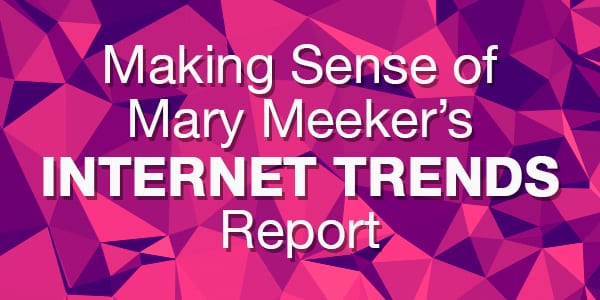 Mary Meeker, an analyst turned venture capitalist at Kleiner Perkins Caufield Byers (KPCB), has published her annual Internet Trends Report for 2017.
Mary Meeker, an analyst turned venture capitalist at Kleiner Perkins Caufield Byers (KPCB), has published her annual Internet Trends Report for 2017.
It’s more than 350 pages of incredible insight on the development of the internet. It explores the impact of technology on society, and the implications for organizations on how we communicate, how we buy and how we live. I got together with our resident online strategy guru Ben Foster to make sense of the findings within the report. Here are our top six takeaways…
1. Internet Growth
Global internet usage continues to grow at a steady 10% per year, reaching 46% of the global population. It’s fueled by developing markets, notably India. Mark 2026 down in your diary as the year when everyone in the world is able to get online, based on current adoption rates.
There’s no sign of a slowdown in our use of internet connected devices. Data for the US shows that consumers spend an average of 5.6 hours per day on the internet. This number has growth 4% year-on-year, fueled by mobile phone usage.
2. Shift to Mobile
As long predicted, this is the first time mobile internet usage is greater than desktop usage. This means that all your communications must be developed for mobile.
That said growth in global smartphone shipments has halted. In developing markets everyone that wants a phone has one. Replacement cycles are two to three years. Adoption in emerging markets isn’t sufficient to drive the growth that the market saw at the end of the noughties but it’s still a strong business, driven by innovation.
3. Marketing Spend
2017 will be the first year that internet spend is greater than TV ad spend.
The ability to target and measure ad performance makes digital advertising attractive to brands. The integration of paid, social and earned is also a driver. Platforms such as Facebook and Google have built powerful tools to plan and measure the success of campaigns. Ads can be tested and tweaked in real time.
Your organization should make sure marketing priorities are aligned to consumer media usage.
4. Human Computer Interface
Voice interaction, picture input, and messaging bots are reaching a level of technical quality that will enable them to go mainstream. This means your consumer touch-points need to be reevaluated for the way consumers will prefer to interact with machines.
Voice recognition has hit 95%. That’s typically the level of understanding that we’d have with each other in a conversation. It’s the reason for the boom in applications and devices such as Alexa, Google, Siri, and now HomePod. The combination of voice and location is incredibly exciting.
Voice isn’t the only innovation in the human computer interface. Image recognition, enabled by phone cameras, processing power, and algorithms provides a powerful means of data entry and search. Google Lens and Pinterest Lens show the potential of this technology.
5. There Is No Line
The line between paid and social is blurring to the point of it being indistinguishable. Social networks are creating new ad formats in a bid to drive revenue and deliver consumers to an online store. Their goal is a frictionless experience for the consumer, and revenue for the brand.
This means you must start building ‘muscle’ in your organization to create content that makes people want to buy instantly.
6. Social Businesses Emerge
Social media is growing up. It is driving accountability and improving customer service. Brave brands are no longer frightened to admit their mistakes. Consumers recognize that brands are people and appreciate candid responses, but expect action.
So called social businesses are emerging built around a strong purpose. Every aspect of the organization is social, from sales to customer service. Customers engage with each other and the business in a community. Meeker suggests that it’s a lean and profitable business model.